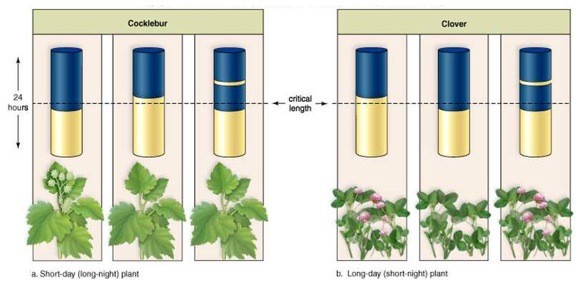 The cylinders in this experiment represent a 24-hour period. The light area represents light periods during a 24-hr. period and the dark area represents dark periods during a 24-hr. period. The critical length of dark vs. light periods for flowering is depicted by the dotted line. Note that some plants are flowering and some are not flowering. Study the results of this experiment on photoperiodism and flowering to determine whether the following statements are true or false.Short-day plants flower when the day length is shorter than the critical length, but the required dark period is interrupted by a flash of light.
The cylinders in this experiment represent a 24-hour period. The light area represents light periods during a 24-hr. period and the dark area represents dark periods during a 24-hr. period. The critical length of dark vs. light periods for flowering is depicted by the dotted line. Note that some plants are flowering and some are not flowering. Study the results of this experiment on photoperiodism and flowering to determine whether the following statements are true or false.Short-day plants flower when the day length is shorter than the critical length, but the required dark period is interrupted by a flash of light.
Answer the following statement true (T) or false (F)
False
Short-day plants do not flower when the day length is shorter than the critical length, but the required dark period is interrupted by a flash of light.
You might also like to view...
Most automated nucleotide sequencing machines detect bands by
A. measuring incorporated radioactivity. B. autoradiography. C. laser induced fluorescence. D. sizing DNA fragments produced by base specific chemical cleavage reactions.
The process of using energy from the Sun to convert CO2 into organic molecules is called
A) respiration. B) assimilation. C) photosynthesis. D) chemosynthesis.
As shown in the accompanying figure, plant cell cytokinesis differs from animal cell cytokinesis because ______.
Fill in the blank(s) with the appropriate word(s).
Which of the following statements about the endoplasmic reticulum (ER) is CORRECT?
A. The rough ER is the site of lipid synthesis. B. The smooth ER has ribosomes associated with it. C. The ER is a lipid storage organelle. D. The ER is a transport system within the cytoplasm. E. The smooth ER is a site of ATP synthesis.